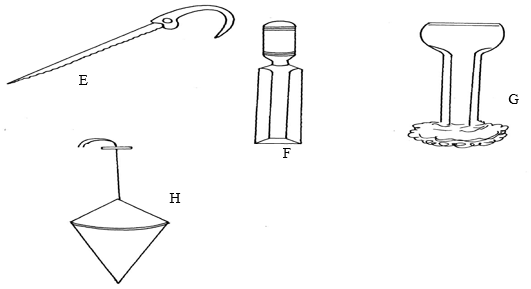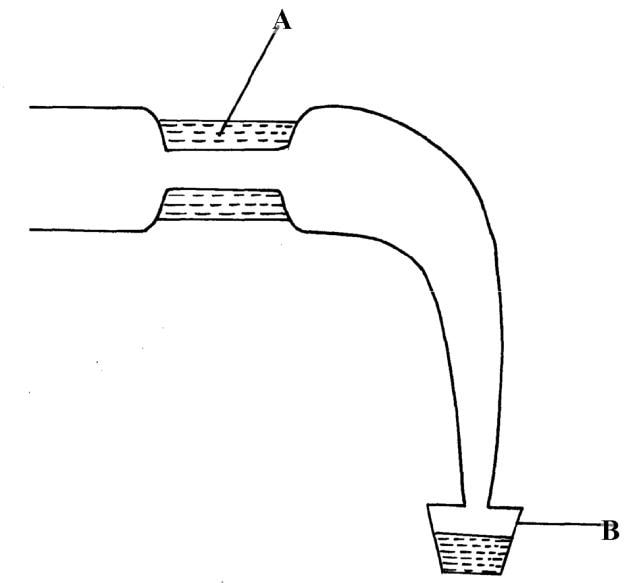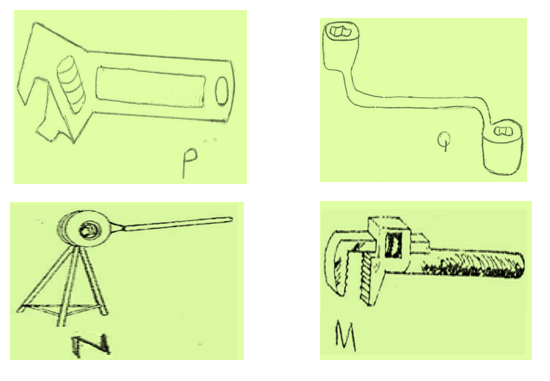CROP PRODUCTION I (LAND PREPARATION)
<
>
Introduction
Seedbed Preparation
Reasons for Seedbed Preparation;
Operations in Land Preparation
Land Clearing
Clearing of land is necessary when:
biology notes
english setbooks
history notes
Operations in primary cultivation
Which can be drawn by;
Depends on:
Choice of Implement
Determined by:
Factors determining number of secondary cultivation:
Ridging; The process of digging soil on a continuous line and heaping on one side to produce a furrow and a bund (ridge). It is important for root crops, to allow root expansion and for soil and water conservation. Rolling: It is the compaction of the soil to produce a firm surface which increases seed-soil contact and prevents wind erosion. Levelling; Production of an even, uniform surface which promotes uniform planting. Sub soiling: This is deep cultivation into the subsoil layer to break up any hardpan which might have developed. It is done for the following reasons:-
Minimum Tillage:
This is the application of a combination of farming practices with the aim of reducing the disturbance of the soil.
Examples of which include:
videos recommended for youSPECIFIC OBJECTIVES
By the end of the topic, the learner should be able to:
TOPICS/SUBTOPICS (7 LESSONS)
Land preparation
Definition Importance Operations in land preparation Clearing land before cultivation
Sub-soiling
QUESTIONS ON TOPIC
1 Comment
FARM TOOLS AND EQUIPMENT - KCSE AGRICULTURE NOTES, OBJECTIVES, SCHEMES, QUESTIONS AND ANSWERS12/12/2017
<
>
FARM TOOLS AND EQUIPMENT (7 LESSONS)Introduction to Farm Tools and Equipment
Farm tools and equipment perform specific jobs in the farm.
They make work easier and more efficient. They can be classified according to their uses as follows: Garden Tools and Equipment
Panga
Cutting and shallow cultivation, making holes. Jembe / hand hoe Cultivation, digging, shallow planting holes and trenches. Fork Jembe Cultivation, digging out roots, harvesting of root crops. Rake Collecting trash, breaking large clods, levelling, removing stones from a seedbed and spreading organic manure. Spade Scooping and carrying of soil, sand, concrete mixture and manure. Spring balance Measuring weight. Trowel Scooping seedlings during transplanting and digging planting holes for seedlings. Pruning hook Bending tall branches when pruning. Secateur Cutting young stems and pruning branches. Tape measure Measuring distances. Axe Cutting big trees and roots and splitting logs of wood. Soil auger Making holes for fencing posts. Mattock Digging hard soils Sprinkler Overhead irrigation Watering can Watering plants in nursery bed Wheel barrow Transportation of soil, fertilizers, farm produce, tools and equipment. Levelling board For levelling a nursery bed Pruning saw Cutting old wood stems and pruning big branches. Hose pipe For conveying water from a tap to where it is need. Knap sack sprayer Applying agro-chemical by spraying. Garden shear Trimming hedges. Pruning knife Removal of small shoots. Meter ruler Measuring distances. Garden fork Shallow digging. Workshop Tools and Equipment
Drenching gun
Administering liquid drugs to animals orally. Bolus gun/dosing gun Administering solid drugs or tablets to animals orally. Wool Shears Cutting off wool from sheep. Hypodermic syringe Administering drugs by injection for example in vaccination. Stirrup (bucket) pump Application of acaricide by hand spraying. Thermometer Taking body temperatures of farm animals. Burdizzo Used in bloodless method of castration. Halter Rope designed to restrain the animal. Trimming knife Cutting short the overgrown hooves. Elastrator Stretching rubber ring during castration, dehorning and docking of lambs. Iron dehorner Applies heat on the horn bud to prevent growth of horns. Nose ring Fixed into the nose of a bull to restrain it. Strip cup Detecting mastitis in milk products. Trocar and cannula Relieving a bloated animal of gases particularly ruminants. Hard broom For scrubbing the floor. Ear notcher Making ear notches in livestock. Bucket For holding milk during milking. Milk chum For holding milk after milking. Milk strainer/sieve Removing foreign particles from milk for example hairs and sediments. Rope Tying or tethering animals. Milking stool Used by the milker to sit on while milking. Weighing balance Weighing milk after milking. Teeth clipper Removal of canine teeth of piglets soon after birth. Chaff cutter Cutting fodder into small bits. Dehorning wire Cutting grown horns. Workshop Tools and Equipment
Spanner
Tightening and loosening nuts and bolts. Pliers Cutting small wires and thin metal and gripping firmly. Files Sharpening tools, smoothening or shaping edges of metals, Rasps Smoothening and shaping of wooden structures. Chisels (wood) Making grooves in wood. Cold chisel Cutting and shaping metal. Screw drivers Driving screws in or out of wood or metal. Cross cut saw Cutting across the grain of wood. Rip saw Cutting along the grain of wood. Hack saw/Bow saw Cutting metals. Tenon / back saw Cutting branches of trees. Coping saw Cutting Joints on wood and fine sawing. Compass/keyhole saw Cutting curves on thin wood. Cutting either along or across the grain of wood especially when cutting key holes. Tin snip Cutting metal sheets. Braces and bits. Boring holes in wood. , Drill and bits Boring holes in metal work and woodwork. Claw hammer Driving in, removing and straightening nails. Ball peen Driving in nails, rivets and straightening metal. Also used on cold chisel, Mallet Hammering or hitting wood chisel. Jack plane Fine finishing of wood. Scrappers/spoke shave Smoothening curved surfaces of wood such as handles of jembes, axes. Metre ruler Measuring short length Try square Measuring length angles and to ascertain squareness. Marking gauge Marking parallel lines to the edge of wood. Fencing pliers Cutting wires, hammering staples when fencing. Vice and clamps Firmly holding pieces of work together. Spirit level Measuring horizontal or vertical levels. Soldering gun Melting soldering rods when repairing or fabricating metal sheets. Wire brush Brushing rough surfaces. Divider Marking and laying out. Centre punch Marking the point of drilling. Paint brush Applying paint on surfaces. Sledge hammer Ramming hardware, breaking stones. Wire strainer Tightening wires during fencing. Riveting machine Fix rivets when joining pieces of metal. Claw bar Removing long nails from wood, straining fencing wires and digging fencing holes. Plumbing and Masonry Tools
Pipe wrench Holding, tightening and loosing metallic pipes.
Pipe cutter Cutting PVC pipes. Levelling rod Levelling the floor during construction. Mason's trowel Placing mortar between construction stones and bricks. Wood float Create a level surface on walls and floors. Mason's square Ascertain verticalness. Plumb bob Spreading screed over floors and walls. Shovel Mixing and scooping concrete or mortar, measuring cement. Care and Maintenance of Tools and Equipment
Reasons for Maintenance
TOPICS
Specific Objectives
By the end of the topic, the learner should be able to:
FARM TOOLS AND EQUIPMENT QUESTIONS AND ANSWERS
1. List four maintenance practice carried out on a cross-cut saw
2. Identify the following tools and state their functions
Identify A, B, C, D
3. Study the illustration below and answer the questions that follow.
i) Identify the equipment represented by the illustration
ii) What is the use of the equipment? iii) Name the parts labeled A and B iv) What is the function of the part labeled A and B 4. What is the use of a garden fork? 5. Name the tool that a builder would use to check the vertical straightness of a wall during construction 6. Name the farm tool that can be used when removing nails from timber 7. Give two examples of equipment that a livestock farmer can use in administering oral anti helminthes 8. Diagrams M, N, P and Q represent some farm tools. Study them carefully and answer questions that follow.
a. Identify the tools M, N, P and Q (2 marks)
b. Give one use of each of the tools names above (2 marks) c. State two maintenance practices that should be carried out on tool M (1 mark)
9. Name a tool used to perform the following functions on the farm;
(i) Drilling of small holes on metal (ii) Bore holes on wood 10. State the common faults in the operation of Knapsack spray 11. (a) Name the three tools in castration of livestock 12. Name the most appropriate set of animal handling tools that a farmer uses for the following operations:- (i) Restraining a large bull when taking it around the show ring (ii) Cutting tail in sheep 13. a) Below are illustrations of farm tools
i) State the use of the tools
ii) Name the type of hammer that may be used for driving tool K during work
14. List two equipments used in handling cattle during an Agricultural exhibition
15. Mention the use of the following tools. i) Dibber ii) Spokeshaves iii) Tinsnips iv) Burdizzo 16. List four precautions that should be taken when using workshop tools and equipment. 17. i) Below is an illustration of a farm equipment. Study it and answer questions that follow
a) Identify the farm equipment illustrated above
b) What is the use of the equipment c) Name the parts labelled W, X and d) What is the functions of Y on the equipment
18. Use the diagram below to answer questions which follow
i) Identify the above diagram
ii) Name the parts labelled A and B
19. Below are illustrations of farm tools. Study them and answer the question that follows:
a) Identify P and M. (1mk)
b) State one advantage of P over Q. (1mk) c) State the function of tool labeled N and M. (2mks) d) Give two maintenance practices that can be carried out on tool P. (1mk)
20. The diagram below is of a farm implement study in carefully and answer the questions that follows.
i. Identify the implement. (1 mark)
ii. Label lparts A, B, C and D. (2 marks) iii. State three maintenance practices carried out on the above implement. (1½ mark)
21. Study the farm tools shown below and answer the questions that follow.
i. Identify the tools labeled. (1½ marks)
ii. State one use for each of the tools B and C (2 marks) iii. Give three maintenance practices that should be carried out on tool A. (1½marks)
KNEC KCSE QUESTIONS AND ANSWERS
SCHEMES OF WORK
MORE KCSE/MOCKS Q & A
|
Categories
All
Archives
May 2021
Quick Agriculture Revision Notes
|
||||||||||||||||||||||||||||||||||||||||||||||||||||||||||||||||||||||||||||||||||||||||||||||||||||||||||||||||||||||||||||||||||||||||||||||||
We Would Love to Have You Visit Soon! |
Hours24 HR Service
|
Telephone0728 450425
|
|
8-4-4 materialsLevels
Subjects
|
cbc materialsE.C.D.E
Lower Primary
Upper Primary
Lower Secondary
Upper Secondary
|
teacher support
Other Blogs
|











 RSS Feed
RSS Feed